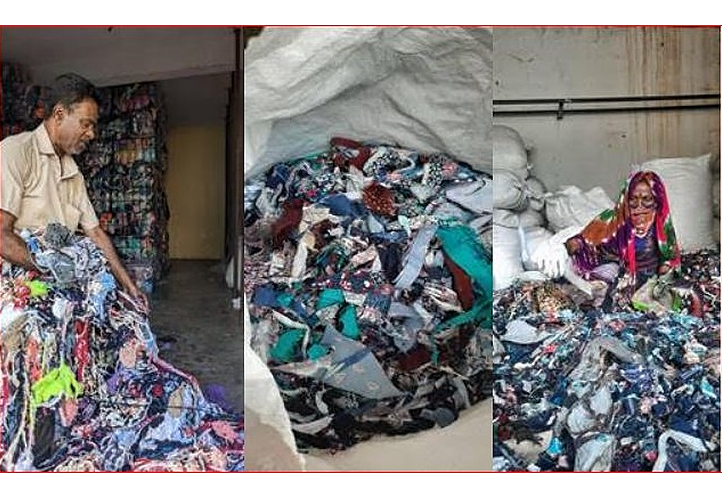Saahas x CAIF Partnership Announcement – Tracing pre consumer textile waste

A bottom-up, micro- entrepreneurship-led approach to make pre-consumer textile waste management more transparent
Pre-consumer textile waste management is characterized by a fairly effective, yet informal and unregulated system of collection, segregation and value creation. The waste that is generated at the manufacturing units gets collected by chindiwalas or large-scale waste collectors, passing it on to waste aggregators who later sell it to various recyclers from where the waste is either turned into recycled fabric, cleaning wipes or fillers. These recycled fabrics and cleaning wipes after their ‘second life’ end up as hazardous materials finding their end destination in the landfills.
The challenges in the pre-consumer stream are multi-pronged. Starting from zero visibility on what happens to the waste after it has been taken out from the factory gates to issues at the segregation and recycling level, the overall opacity of the system makes it even more challenging to plug in the loopholes and function in a transparent manner. Any remedial action will require a thorough understanding of the issues involved at different levels as this opacity creates blind spots that restrict any action.
Brands and manufacturers lack visibility of the journey of such waste– Brands and manufacturers have no visibility of what happens to this waste once it is taken out from the factory gates. The fabric which is made at the manufacturing units is paid for by the brands, which means that by extension the ‘waste’ that is generated during the process is a part of the fabric which the brands have paid for already. Brands, therefore, have an interest in working with manufacturers on interventions that can provide much-needed transparency about the journey of pre-consumer waste and more importantly, bring such waste back into the production loop. They are also experiencing increasing regulatory scrutiny on what they are doing to manage such waste.
The monopoly of traders/aggregators– Large aggregators and traders are unwilling to divulge information about what happens to the waste once it’s collected from the factory premise as they fear losing competitive advantage in the process of making the supply chain transparent. Any new trader finds it difficult to enter into this network and establish their business with complete transparency.
The existing waste collection mechanism has limited coverage- The existing system of pre-consumer waste collection described above largely caters to the needs of large manufacturing units. In the case of small and medium-sized enterprises, the volume of waste is much lower, making it unprofitable for large traders to routinely collect the waste from their units. With limited or no mechanism in place for collection, much of their waste is eventually dumped into landfills.
Lack of standard practice for segregation– In most cases, large manufacturing units have the first level of waste segregation done at their premises. However, in the case of medium and smaller units, such segregation becomes a challenge due to the lesser volume of waste being generated at the unit.
With this backdrop in mind, CAIF has launched a pilot programme with Saahas Zero Waste to work with hyperlocal waste micro-entrepreneurs and build a model for pre-consumer waste management that brings transparency in the handling of the waste stream, contributes to closing the loop on textile waste and creates green jobs in the process.
“Closed loop or transparent recycling is extremely challenging or absent from the textile waste sector altogether. Pre-consumer textile waste is considered clean waste and has a certain limited solution, formal as well informal with very low transparency of the waste value chain and ecosystem. However, the infrastructure on the ground continues to be inadequate and we face enormous difficulties in getting all the types of textile waste collected and recycled formally. In all these years, the industry has just not invested in designing closed-loop systems, either on solutions for mix-composition waste or formalizing the existing informal ecosystem. We hope that this will quickly change as the industry adopts the norms of a circular economy.” – Astha Khubele, Senior Project Manager | Circular Textile, Saahas Zero Waste
How is this pilot looking to solve the challenges associated with the pre-consumer waste stream?
How are we bringing transparency into the current pre-consumer waste stream?
A digital platform is set up to trace the outflow of the waste material right from the factory gates to the point of selling the segregated waste to different recyclers. The tracing of the waste flow will provide valuable insights into the quantity of waste collected, segregated and sold to multiple buyers of this waste.
How are we supporting green microentrepreneurship?
In our joint effort toward creating a transparent waste system and building green entrepreneurship, we will be testing a micro-entrepreneurship-led approach for local collection, sorting and selling of pre-consumer textile waste. The pilot will also lay the foundation for creating green job opportunities for the waste worker community while ensuring social and environmental compliance.
“What is really interesting about this pilot is that we are testing this model with a micro-entrepreneur in a market that is otherwise dominated by large traders and aggregators. Taking the first steps to bring transparency in the waste chain required us to work very closely with the entrepreneurs and take a closer look at the ground realities and build the pilot in consultation with them to address the challenges every step of the way”- Ipshita Das, CAIF, Intellecap
This blog is part of our knowledge series highlighting updates and learnings from the “Closing the Loop on Textile Waste” Project, in partnership with Enviu, and supported by the IKEA Foundation.




